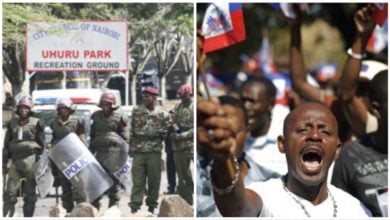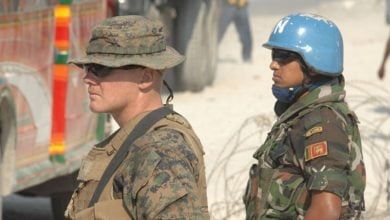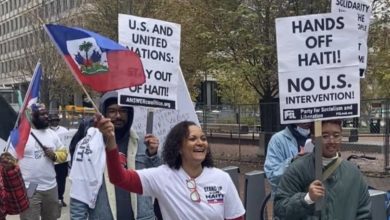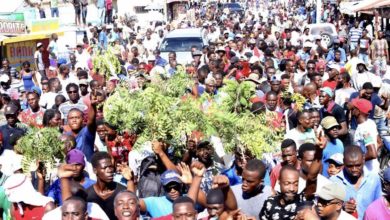 Haitians protesting for justice. Photo: Haiti Progres |
During that demonstration, police shot and killed at least two demonstrators. U.S.-installed de facto Prime Minister Gérard Latortue later boasted about it. “We fired on them, some of them went down, others were wounded, and others fled,” he announced with no words of regret.
The police then skirmished with armed anti-coup partisans from the capital’s popular quarters like Bel Air and Martissant in the following days. There have been dozens of casualties on both sides.
Latortue’s government has become increasingly isolated and prone to issuing absurd accusations against Aristide to explain the Haitian peoples’ growing insurgency and militancy.
In mid-October, Latortue lashed out against Aristide’s host, South African President Thabo Mbeki, as “not respecting international law” by allowing the Haitian president “in his territory to organize violence in another country.”
South Africa’s foreign minister brushed off the attack “with contempt,” saying that Latortue was using Mbeki as “a scapegoat for failure by the interim Haitian authorities to bring about peace and stability to Haiti.”
Latortue’s repression has only stoked the fires of rebellion. Spontaneous demonstrations and burning tire barricades occur every week. In response, the de facto government has illegally arrested and jailed dozens of Lavalas leaders, including constitutional Prime Minister Yvon Neptune, Interior Minister Joclerme Privert, activist Annette “So Ann” Auguste, and refugee rights pioneer Father Gérard Jean-Juste.
The attack on the poor masses is even more brutal. On Oct. 19, masked policemen gunned down a 9-year-old boy in the capital’s La Saline slum. A week later, they returned to a house in Fort National where they arrested and then executed 13 unarmed young people, including three women. Two days later, four youths, two with their hands tied behind their backs, were executed in broad daylight on Rue Péan in the capital’s most rebellious slum, Bel Air.
The de facto government has denied that the massacres are carried out by the police, blaming them on either “renegade” police units or “death squads posing as policemen.” The masked black-clad policemen carrying out these massacres may in fact be former soldiers from the Haitian army, which Aristide dissolved in 1995. Two or three hundred of these former soldiers were the core of the “rebels” that invaded Haiti in January 2004 from the Dominican Republic, where they were equipped, trained and harbored with the support of both the U.S. and Dominican governments.
Since providing the media backdrop for the U.S. Marines’ kidnapping of Aristide on Feb. 29, the “rebels” have been clamoring for resurrection of the Haitian army as well as for 10 years of back pay, claiming the army’s dissolution was illegal. After several deadly clashes with the police during September, the former soldiers struck an uneasy truce and unpublicized deal with the de facto authorities. Some were integrated into the police force while others set up bases in provincial cities and performed parallel or joint operations with the police and the occupation forces of the United Nations Mission to Stabilize Haiti (MINUSTAH).
The former soldiers, along with death squad leaders and former Tonton Macoutes-henchmen from the Duvalierist dictatorship-have expressed eagerness to put down the growing revolt in the Haitian capital.
Despite the savagery of the massacres, popular neighborhoods are not intimidated and continue to repel police attacks. At least three times during October, armed anti-coup militants in Bel Air expelled incursions by the police backed by occupation troops. On one occasion, UN troops abandoned their vehicle and weapons.
Resistance is not confined to the capital. In a significant development, a well-organized commando attacked the police station in the northwestern town of Gros Morne just after midnight on Oct. 24, subduing the policemen and reportedly capturing weapons. One policeman was wounded in the leg while fleeing.
The guerillas spray-painted slogans on the police station and neighboring buildings saying “Down with the occupation,” “Down with the former soldiers,” and “Down with the Macoutes!” Along with a red star, they also left their name: the Dessalinien Army of National Liberation (ADLN). Jean-Jacques Dessalines was the founding father of Haitian independence 200 years ago.
George W. Bush’s electoral victory on Nov. 2 will also have a dramatic effect on the Haitian struggle in coming weeks. Prior to the election, Aristide’s Lavalas Family (FL) party was clearly clinging to the hope that Democratic hopeful John Kerry, if elected, could be persuaded to return Aristide to the Haitian presidential chair, just as President Bill Clinton did with an occupation of 20,000 U.S. troops in September 1994. Aristide, from his South African exile, made repeated calls for “dialogue” with the U.S. and France, the very nations which fomented his ouster in the first place.
It is unlikely that the FL leadership can continue to make moral appeals to French and U.S. imperialism, especially with the Bush administration’s hard-liners that are encouraged by their electoral victory and hungry for new attacks, particularly against neighboring Cuba.
 Photo: Bill Hackwell |
“We think that because the ruling sectors have put an end to the civil form of struggle, it would be an illusion to think that the normal democratic approach to political power could be practical in the current context,” PPN Secretary General Ben Dupuy said in an interview in the September 2004 issue of Socialism and Liberation. “So we leave every door open. We think it is the duty of any people to fight illegitimacy, tyranny.”
In many ways, the political conjuncture in Haiti today mirrors what existed in 1803 when Napoleon Bonaparte wanted to reestablish slavery, when the colony’s ruling groups were feuding among each other for privileges, and when the French empire was fighting wars of expansion on many fronts.
Today, the Haitian masses will not accept the ruling classes’ overthrow of the government they overwhelmingly elected in 2000-imperfect as it was. They will not allow the modest gains in economic and political rights they won since dictator Jean-Claude Duvalier’s fall in 1986 to be crushed. The comprador and big landowning factions of the Haitian ruling class are also fighting among themselves, as they have historically, over the political power they snatched from the people in the Feb. 29 coup.
Finally, the U.S. empire, just like Napoleon’s France, is hugely overextended. It finds it necessary to “outsource” its occupations to surrogates-in Haiti’s case, to the Brazilian, Argentine, and Chilean troops that make up the bulk of the MINUSTAH. These nations have no stake in enforcing Haiti’s continued subjugation other than whatever diplomatic and financial bribes the Bush administration has offered them. As the situation worsens, which it surely will in the months ahead, they can be expected to look for ways to extricate themselves from the quagmire in which they find themselves sinking.
In short, the conditions for revolutionary change in Haiti today are as favorable as they were 200 years ago. Just as the former slaves of St. Domingue rose up and founded a new republic that sparked the liberation of South America, the Haitian masses once again stand positioned to open a new chapter in the hemisphere’s history and the liberation of mankind.
Kim Ives is a writer with Haíti Progrés newspaper.






